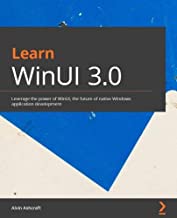I’m thrilled to announce that my new book from Packt Publishing, Learn WinUI 3.0, was published in late March. You can buy your eBook or print copy today from Amazon or Packt’s web site.
Windows UI (WinUI) 3 is Microsoft’s next generation library for creating Windows applications with Fluent Design. WinUI 3 was released in March with Project Reunion 0.5 and is fully supported for building Win32 applications. Learn more about WinUI and Project Reunion on Microsoft Docs here.
I would like to thank Nick Randolph, who was the technical reviewer for the book. His feedback on the book’s chapters and sample code were instrumental in delivering a great resource for Windows developers. I was lucky to have him involved in this project. If you aren’t already following Nick’s blog, go check it out now. He has been posting some great WinUI, Reunion, and Uno Platform content in recent weeks.
If you would like to win a print copy of Learn WinUI 3.0, read on. I am going to give away four copies of the book to readers of four of my blogs:
- The Morning Dew – www.alvinashcraft.com
- UWP Tips – www.uwpapp.tips
- WPF Tips – www.wpf.tips
- WinUI Tips – www.winui.tips
Leave a comment on this post on any of these blogs with the name of your favorite Windows or .NET development blogger. I will pick a random comment from each blog to select the four book winners. You can comment on each blog if you like, but please only comment once on each post. Comment moderation is enabled on all the blogs, so it could take a little time for your comment to appear. Make sure you sign up with a valid email address when leaving a comment. The contest closes at 11:59PM EDT on May 14th, 2021. I will ship books to winners worldwide. Please allow some time to receive the book if you are outside of the U.S.
Good luck and I hope you all enjoy my book! If you already have a copy, win one, or buy one, please leave honest ratings and reviews on Amazon. Thanks!




